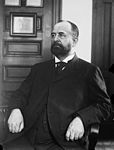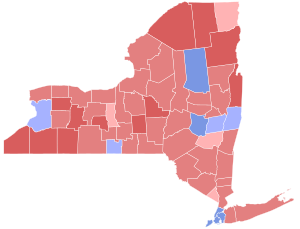|
1898 New York gubernatorial election
The 1898 New York gubernatorial election was held on November 8, 1898. Incumbent Republican Governor Frank S. Black was defeated for re-nomination by Theodore Roosevelt, the former United States Assistant Secretary of the Navy and a returning hero of the Spanish–American War. In the general election, Roosevelt narrowly defeated judge Augustus Van Wyck. Republican and Citizens Union nominationCandidates
CampaignReturning from Cuba as a war hero, Theodore Roosevelt had popular approval but lacked support from the state's Republican political machine, which he had opposed as a member of the State Assembly and Police Commissioner. Instead of directly approaching Republican bosses Thomas C. Platt and Benjamin B. Odell, Roosevelt approached the Citizens Union, a good government organization, and suggested the nomination of a state ticket. The Citizens' Union Executive Committee endorsed the Roosevelt plan with only three dissenting votes.[1] An "Independent Citizens Committee" was formed, and six thousand signatures were gathered on a petition to file a ticket, with the signers believing that Roosevelt headed the ticket and that the Citizens Union backed it.[2] Facing uncertain prospects of a three-cornered election against Roosevelt and the Democratic Party, the Republican bosses instead offered Roosevelt the nomination against the wishes of Governor Frank S. Black. On September 24, three days ahead of the Republican state convention, Roosevelt suddenly declined to run on the independent ticket. ResultsThe state convention met on September 27 at Saratoga Springs, New York. Sereno E. Payne was Temporary Chairman until the choice of Horace White as Permanent Chairman. Theodore Roosevelt was nominated for governor on the first ballot.[3]
AftermathOn September 30, Robert Fulton Cutting and a majority of the Citizens Union Executive Committee rejected the idea of a state ticket as "not only inconsistent with, but actually opposed to the fundamental principles and objects of the Citizens' Union."[5] However, the Independent Citizens' Committee declared the next day that they would proceed with nominations.[6] The petition to file an independent ticket with Roosevelt as its nominee was filed with the Secretary of State on October 12. Roosevelt immediately sent a letter to the Secretary of State declining to run on the independent ticket, which would have threatened Republican candidates for lower offices.[7] The Independent Citizens' Committee substituted Theodore Bacon, a lawyer of Rochester, on the ticket, and Cutting, despite his earlier rejection of the state ticket idea per se, campaigned for the ticket.[8][9] Democratic nominationCandidates
ResultsThe Democratic ticket was a compromise between the three biggest Democratic bosses: David B. Hill from upstate, Richard Croker of Tammany Hall, and Hugh McLaughlin of Brooklyn.[10] The Democratic state convention met on September 28 and 29 at Syracuse, New York.
AftermathThe day after the Democratic convention, the National Democratic Party state committee met on September 30 at 52 William Street, New York City. The committee resolved not to call a convention or endorse any candidates.[12] General electionCandidates
Results
See alsoNew York gubernatorial elections Notes
Sources
|
|||||||||||||||||||||||||||||||||||||||||||||||||||||||||||||||||||||||||||||||||||||||||||||||||||||||||||||||||||||||||||||||||||



